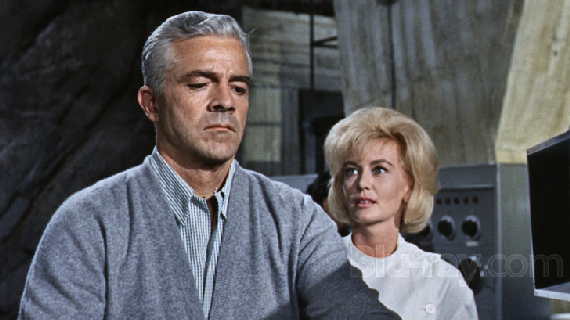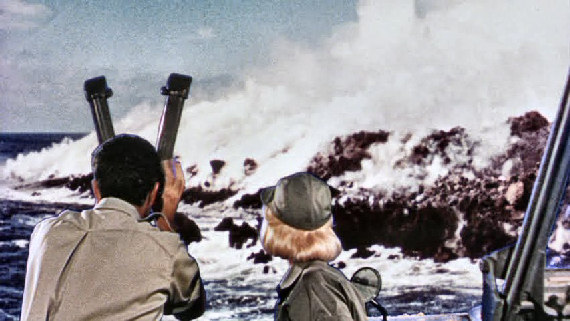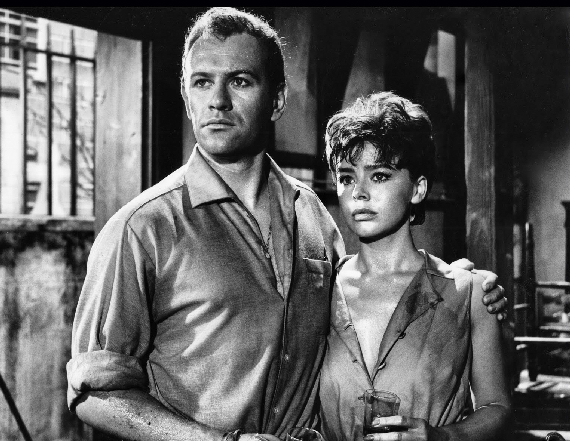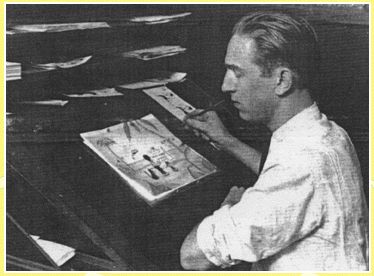
I seem to be on a retro kick lately, for various reasons. (Okay, you caught me out—a lot of the new movies aren’t really good enough to review, or aren’t genre, and the blockbusters are usually reviewed by hundreds of people, so why compete?) But it seems to me that there’s a lot of value in many of the older SF/F movies, even if the effects aren’t up to today’s standards. (In fact, because they didn’t have the luxury of being able to show whatever they could think of—as we practically can, today—they had to be creative, through writing and/or acting, to make up for what might be seen today as deficiencies in effects. But if you’ve seen the best kind of matte work, the kind they don’t do by hand any more, you know what I’m talking about (see Figure 8). Another thing, in my opinion—and it’s just an opinion—is that in the ‘50s and early-to-mid ‘60s, British SF/F films were usually better than their American counterparts. It seems to me that British filmmakers were usually interested in making good movies per se, no matter what the genre, while many American filmmakers were okay with putting out schlock as long as it did well at the box office. Remember, these were still the days of A- and B-movies and movie stars; a cheaply-made movie could do well as a B-film if it was paired with a fairly good A-movie. Another thing about reviewing old movies is that—when I can find the ones I want, which isn’t always easy in these days of few video stores—I can now see them in higher definition (and sometimes in colour) as I’ve never seen them before. (Often I’ve only seen them on a smaller black-and-white TV in broadcast quality or VHS; but a couple of years ago I bought a 50-inch 3D flatscreen for just this purpose!) Anyway, in this review I’m going to talk about a couple of British “end-of-the-world” (Figure 1) SF films from the ‘60s. And since both movies are over half a century old, I’m gonna have spoilers. Sorry ‘bout that!

Something else the British do extremely well is “end of the world”-type movies. Crack in the World (1965) features two stars that are mentioned in “Science Fiction/Double Feature” from Rocky Horror Picture Show, namely Dana Andrews and Janette Scott. No prunes or triffids in this movie, however, which is about a scientist (Andrews) and his wife (Scott) who are seeking to tap the Earth’s magma for a project they figure will solve the world’s power problems for the foreseeable future. (This movie reunites Scott on screen with Kieron Moore, who was one of her co-stars from Day of the Triffids, 1963, however; and who was, in real life, her husband.) This film came out the year I after graduated from high school, and previously I’ve only seen it on TV, so I was glad to get a chance to revisit it. Andrews plays Dr. Stephen Sorenson, whose geothermal project in Tanganyika has drilled down to an impenetrable layer above the Earth’s magma that seemingly can’t be cracked by any drill or explosive available to the team, so Sorenson seeks approval from Sir Charles Eggerston (Alexander Knox), who heads up some kind of board in Britain, to use a nuclear device, the only explosive powerful enough to get through the layer. In opposition to this plan is fellow scientist Dr. Ted Rampion (Moore), who is afraid the device will break the world apart due to cracks in the layer from atomic testing around the globe. In addition, Rampion is Sorenson’s wife’s ex-boyfriend, adding a certain tension to the equation. Sorenson sees Rampion’s opposition partly as a form of jealousy, and partly as self-aggrandization, because the “Rampion Theory” has gained a certain worldwide scientific credence. He has sent Rampion off on an errand while Sir Charles visits the site and plans to minimize the dangers involved. Unknown to Sorenson’s wife and the rest of the crew (and the scientific world), Sorenson has just learned that a rash he’s had on his left hand and arm, which are being treated on-site with radiation, is from some virulent disease which is actually untreatable and will soon kill him. Sorenson sees the project as his heritage and is determined to see it through.

Rampion arrives back in Tanganyika to find that Sorenson has done an end-run around him and gotten the board’s approval, so heads off to Britain to try to convince the board that this explosion will end the world. While he is gone, Sorenson and his crew send the missile down the shaft. At first, it appears to be a success; magma wells up from the borehole, but soon they discover that a fissure has appeared and earthquakes are happening along the fissure and thousands of people are dying along the fissure’s route as it grows in length. The fissure appears to be set to girdle the Earth, and if it does so, the Earth could crack apart like… well, you know, a hard-boiled egg! Sorenson is becoming more reclusive and pushes his wife away from him—not wishing her to know he’s dying—and towards her ex-lover Rampion, though she is confused and has no idea what’s going on with him. Meanwhile, someone or other (by this time I’m confused—maybe it’s Rampion) decides that if another nuclear bomb is exploded along the line of the fissure at a certain point, it might relieve the pressure from below and stop the fissure in its track. So they do that, and at first it appears to work. But then it begins growing again, and this time it appears to have changed course and will no longer girdle the Earth, but will circle back and meet itself, relieving the pressure and possibly creating a second moon, as the circled part (about 20,000 square miles) will no longer adhere to the rest of the planet. (I’m not quite sure how that was supposed to work.)

Anyway, after lots of drama—the original drill site would be destroyed by the crack, and Sorenson locks himself in his office to record his impressions so there would be a record—though I’m not sure how the record was supposed to survive; Maggie Sorenson and Rampion become a couple again as they fight through adversity, and the Earth gains a new moon as a 20,000 square-mile chunk heads off into space. The science here is a bit weak; I’m not sure you could stand next to it as a chunk of the planet broke off without suffering some kind of effect, although a chipmunk comes out and frolics after it does so, proving everything’s going to be all right. Okay, that part was really hokey (anyone remember the aftermath in Mars Attacks, with all the animals?), but overall, the movie had a fair amount of suspense, and there was a very good use of stock footage of volcanoes, earthquakes, atomic explosions, etc., artfully integrated with the film. I also don’t believe that a chunk of the Earth would break off under those circumstances… but I thought the movie was pretty well done despite the scientific flaws (and things like Maggie, who’s a Ph.D., mispronouncing “seismograph” as “seezemograph,” and other stuff). And it’s still worth watching.

And now we come to what I feel is the better of the two featured films, The Day the Earth Caught Fire (1961). This one’s directed by Val Guest, who’s not unknown in the genre—in fact, he directed The Quatermass Experiment (1955) and Quatermass 2 (1957), both highly regarded in British SF (we’ll just ignore When Dinosaurs Ruled the Earth [1957], shall we?). It stars Janet Munro (known for roles in films like The Crawling Eye [1958], Darby O’Gill and the Little People [with Sean Connery] [1959], and Swiss Family Robinson [1960]), “introduces” Edward Judd (in his first leading role, though he’d already had bit parts in a couple of dozen movies and TV shows); and co-stars Leo McKern who, despite an extensive movie and TV career beginning in 1951, had yet to achieve acclaim in such TV shows and movies as The Beatles’ Help (1965), The Prisoner (1967-68), Ladyhawke (1985) and perhaps his best-known role as Rumpole of the Bailey (1978-92). With a cast of this quality, how could you miss? (And they didn’t!) In fact, most of the cast with the exception of the newspaper’s chief editor, was terrific.

Interestingly enough, although it’s a black-and-white film, it begins with an orange-coloured sequence—supposed to represent London in the heat—of absolutely fabulous matte paintings of the river Thames, dried up—you see cracked, dry riverbed, boats on their sides, and Tower Bridge in the distance in one shot. The camera cuts to Picadilly Circus, hot and deserted; an official car with an odd sort of air conditioner on the top is driving through, and someone in the car announces through a loudspeaker that there are now nineteen minutes left in the countdown. The camera cuts to Peter Stenning (Judd), walking sweatily and unevenly down the centre of a deserted London street, a bandage on one hand. He walks in the doorway of a building and we are in the lobby of the Daily Express, a large—but empty-seeming newspaper. He first goes to the elevator, then realizes it’s not working and so clumps weakly up the staircase in the rear; he arrives at a large, deserted newsroom and walks to his typewriter; grabbing several sheets of paper and carbons, he attempts to roll them into the typewriter before realizing the rubber platen has melted! Shoving the typewriter away from him, he pulls the phone close and dials; he calls down to the switchboard where Jeannie Craig (Munro) answers, he asks her to get him anyone who can take copy down. She connects him to a sweaty man in the newsroom, wearing no shirt (only a singlet), who reluctantly agrees, and he begins to talk. “It is exactly (he checks his watch) thirty minutes ago, that the corrective bombs were detonated. Within a few hours, the world will know whether this is the end… or a new beginning….” The camera pans to a row of silent teletypes, and there is a ripple on the screen, which goes to black and white, as the teletypes begin clattering.
We discover that the U.S. has detonated a new type of atomic bomb in the Antarctic; the newsroom is filled with all kinds of chatter—the dialog in this movie is as swift and well-done (people talking over each other in some places) as any episode of The West Wing—and over time we learn that Stennis used to be a big shot at the paper, but has lost his edge (we suspect alcoholism; he spends an inordinate amount of time away from his desk) and is now serving as a backup and almost a copy boy for science writer Bill Maguire (McKern), and he bitterly resents it. Stennis is by turns arrogant and condescending when he tries to get information on the atomic tests from the Minister of Science, finally telling the “new girl” (Munro) on the Ministry switchboard to “go jump back in the pool.”

Anyway, in an attempt to go the Americans one better, the Soviets announce they have detonated an even bigger bomb in Siberia. Maguire does some math and realizes that both bombs—American and Russian—were detonated at the same time on opposite sides of the Earth. This has consequences; at the time of the detonations, various parts of the world were experiencing torrential rains, unlike any other rains in recent history. After the detonations, the rains stop and the world begins to heat up. Newspaper headlines scream “Brighton at 95!” which is great for tourism, but maybe not long-term. (As you probably know, Brighton’s a popular seaside resort about fifty miles south of London.) We get lots of shots of things getting hot around the world. A solar eclipse comes ten days early, and nobody seems really concerned, but Maguire figures out, and the Ministry confirms, that the simultaneous explosions have tilted the Earth’s axis and the weather will be different from now on. Stennis meets Jeannie when he goes to the Ministry instead of trying to phone; she gives him the cold shoulder when she realizes who he is. Later they meet up accidentally when he is returning from taking his son to the amusement park (he’s divorced but takes his son out on weekends). They strike up an acquaintanceship. Later, she tells him in confidence—because she has to tell someone, she says, even though things you learn at the switchboard are confidential—that the “boffins” (scientists) have figured out that the simultaneous nuclear explosions not only tilted the Earth’s axial tilt, but have actually changed the Earth’s orbit, and we’re all going to get so close to the sun that (in Maguire’s words) “The universe will be filled with the delightful scent of charcoaled Mankind.” Stennis breaks his word to Jeannie and phones in the story; the paper runs with it—basically screaming “We’re all gonna die!” in 120-point type, and Jeannie is taken into custody for disclosing secret information.

The film uses all kinds of stock footage: blizzards, cyclones, forest fires, etc., interspersed with nice practical effects (the Londoners coping with cyclonic winds was very good) and, as I mentioned, matte paintings (Figure 8). People riot all over the world—we’re treated to a cute little segment of rioting teenagers dressed like sweaty beatniks and playing jazz (just what I’d do if I thought the world was ending)—on a side note, the “beatnik” music was composed by Monty Norman, whom you may know as the composer of the original James Bond theme! Eventually, the nuclear powers all get together and decide to detonate a bunch of bombs in Siberia to see if they can offset the axial tilt and orbit shift, which takes us back to the beginning of the movie. I’ll let you guess whether it works or not.
One thing that bothers me: the movie was given an “X” rating by the British Film Board or whomever (the certificate is shown at the very start, telling us that nobody under 16 can see it); it’s probably because they’ve been sexualizing Munro since practically the beginning of the movie; as she bends over the switchboard in her first appearance, her blouse falls open, showing a fairly large amount of breast, plus they show a tantalizing (for guys, anyway) number of shots where it looks like you’re going to see her chest. I’m not sure how that stuff fits into the movie, really. Plus Judd was really pushing hard to get into bed with her, and eventually succeeds. (Although he appears to be the main protagonist of the movie, he’s really not a sympathetic character; for my money, Maguire (McKern) is the best person. The person playing the chief editor is also not very good… in fact, his acting is so bad that I figure he must really be an editor that they brought in for verisimilitude.
But regardless, and despite those quibbles and cavils, I really enjoyed this movie, especially as I’d never seen it in high quality video before. I plan to continue looking for worthwhile SF/F films of the ‘50s and ‘60s, and pointing them out to you for your enjoyment and/or edification!
*Figure 1 courtesy of Brazil Weird News and Lygia Cabus (ligiacabus@uol.com.br). No picture credit or copyright found.
If you want to comment on this week’s column, it’s free, and easy. You can register and comment here, or on my Facebook page, or in the several Facebook groups where I publish a link to this column. I love seeing your comments, whether you agree with what I say or not. My opinion is, as always, my own, and doesn’t necessarily reflect the views of Amazing Stories or its owners, editors, publishers or other bloggers. See you next week!










